Maya Deren's imigrant family arrived in New York state in the 1920s, escaping pogroms during one of the more violent anti-semitic outbursts in the Ukraine. In the early 1930s Maya attended the League of Nations School in Geneva, Switzerland, then returned to the US to attend Syracuse University, & became active in socialist politics. She married too young -- it wouldn't last -- & became a fixture of Greenwich Village activist circles.
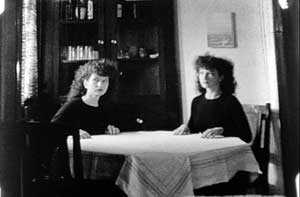 While working as personal secretary to dance choreographer Katherine Dunham, Deren went with the Dunham Dance Company to Hollywood & there met cameraman Alexander "Sasha" Hamid nee Hackenschmied. He would become her second husband, moving with her to Greenwich Village. Throughout this period she pal'd around with Andre Breton, Marcel Duchamp, John Cage, Ana‘s Nin & suchlike. While working as personal secretary to dance choreographer Katherine Dunham, Deren went with the Dunham Dance Company to Hollywood & there met cameraman Alexander "Sasha" Hamid nee Hackenschmied. He would become her second husband, moving with her to Greenwich Village. Throughout this period she pal'd around with Andre Breton, Marcel Duchamp, John Cage, Ana‘s Nin & suchlike.
With a small inheritance upon her father's death, she bought the 16 mm Bolex camera with which she would make her first film Meshes of the Afternoon (1943) in collaboration with Sasha.
A psychologically twisted & terrifying dream-fantasy, Meshes would forever stand as Maya Deren's best art film, a landmark of the avant garde cinema. The classical-sounding Japanese instrumentation was composed by Teiji Ito & added to the silent film in 1956.
Teiji was Maya's third husband, though much younger than herself. The score is brilliant & truly completes the film, mixing classical Japanese instrumentation with modern experimental music.
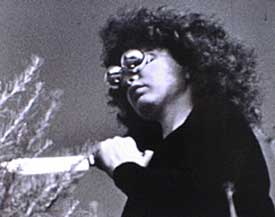 As the film begins, an impossibly long arm reaches downward from the sky & places a stemmed rose or peony on the ground. As the film begins, an impossibly long arm reaches downward from the sky & places a stemmed rose or peony on the ground.
A woman passing by bends down to pick up the flower, continuing home. We see only her shadow, her feet, her hands. Inside her home we see a dark loaf of bread on a table with a large knife for slicing the bread; a phone off the hook; a cheap record player.
She seats herself, gazing out a picture window, & we've a close-up of her right eye as she falls asleep & dreams of a mirror-faced cowled woman walking away carrying the peony. The dreamer gives chase, but soon stops the pursuit & now for the first time we see her, a young woman, beautiful, curly messy hair. It's Maya Deren.
The wandering dreamer enters her house & looks at some of the same things seen previously; she looks for herself; she hangs from the staircase then drops & flies above her possessions. She flies herself asleep in the plush chair.
Gazing from the window she sees herself pursuing the cowled woman, giving up the chase, returning home to where two of her are already present.
Her third self peers from the window & sees herself pursuing herself pursuing the mirror-faced cowled woman, giving up, entering the house. There are now four of them, one sleeping, the others sitting at a table coping with the key that turns into a butcher knife. One of them, wearing bizarre glasses, conceives the idea of killing their most vulnerable, sleeping component.
She awakens & there's a young man (Sasha Hamid) leaning over her with the peony. He walks away, hangs up the phone. She looks around for the other selves, catches a glimpse of a dress's hem vanishing around a corner. She goes to bed with the peony beside her, & the young man begins to touch her. She has the knife ready, as if to kill him.
But then the young man is seen walking down the street, finds a peony on the ground, picks it up, continues to his home, & finds the woman dead in the plush chair.
Meshes of the Afternoon is a beautiful, morbid, poetic silent film, as much horror as avant garde, a disturbing dream. In 1947 Maya received the Grand Prix at Cannes for Meshes. She was on a role artistically & became a Gugenheim Fellow that same year.
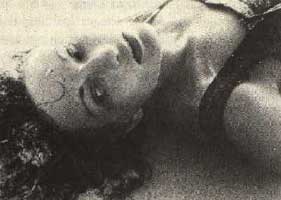 At Land (1944) in abject silence from the first scene establishes sound of the imagination by opening with a violent surf, & Maya on the beach laying exhausted in the sand, as though washed ashore.
At Land (1944) in abject silence from the first scene establishes sound of the imagination by opening with a violent surf, & Maya on the beach laying exhausted in the sand, as though washed ashore.
The sea imagery that will recur throughout At Land reflects Maya's own sentiment that she, having been an immigrant child at age five, was born of the sea. Her Greenwich Village studio was decorated with seashells & a phosphorescent sea-scape painted on the ceiling.
From the beach, she begins to climb through a tangle of driftwood, higher & higher until she reaches a banquet room of people smoking & drinking. She climbs from the beach onto the long table.
As she crawls along the table on her belly, she's not noticed, & she momentarily imagines she is crawling through a forest. At the far end of the table a man plays chess but leaves his seat before she reaches him. She gazes at the chessboard as the people in the room are leaving. She imagines the future play on the chessboard, in stopmotion animation.
A stricken chess piece falls from the table through a hole onto the beach, & suddenly she's back exploring the shore, trying to save the chess piece. She finds herself on an old dirt road at first alone, but then a young man walks beside her speaking, inviting, leading.
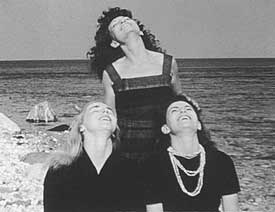 He leads her to a log cabin, but she can barely keep up, & he closes the door before she arrives; it's a moment that most clearly identifies this as a film about loss & abandonment. She crawls under the cabin & up into a large modern home, obviously not the cabin, with furniture covered in sheets. He leads her to a log cabin, but she can barely keep up, & he closes the door before she arrives; it's a moment that most clearly identifies this as a film about loss & abandonment. She crawls under the cabin & up into a large modern home, obviously not the cabin, with furniture covered in sheets.
She finds an old man sick in bed under a sheet. They watch each other without speaking then she goes into the hall & through a door onto a cliff's edge. Entranced, she lowers herself down the cliff, back to the edge of the sea, & sets out across dunes.
She gathers wave-smoothed stones. She approaches & stands close to two women sitting above the reach of the waves, playing chess. The blonde woman, playing the white pieces, is Hella Hamon whom Maya credited as a co-director, who lived with her & Sasha in the small Greenwich Village studio.
Several feminist film commentators have noted the lesbianistic content of this sequence, & though there's no question but that Maya was straight, & that Hella had been in love with Sasha, it certainly wouldn't be odd or alarming that the threesome living in such close quarters were experimental about more than filmmaking. This applies to her tendendency to present doppelgangers in her films, so that women with women becomes comparable to self with self.
The two women playing chess don't seem to notice the hovering watcher until she begins to caress the women's hair & the three of them become aroused.
She grabs a white piece from the board & runs off, but there is another Her still gathering stones. The stone-gatherer looks up & sees herself running along the top of a dune with the stolen chess piece. A third self may well still be with the other two women.
A scene by scene discription of this film exists including at least one unfilmed sequence. That discriptive screenplay indicates that the chesspiece taken was the Queen, but I've run through the scene several times & cannot see that it's the queen. I believe it is the same pawn that fell from the banquet table onto the beach, & which she had long sought to save.
This quarter-hour film is the one that most closely captures the mysteriousness of nightmare so strikingly presented in Meshes, though Maya would never really equal that first great work, an assertion that confronted her during her life & with which she strongly disagreed.
 More or less completing her trilogy of the mystical multiplying Self, Ritual in Transferred Time (1946) revisits the doppelganger theme. More or less completing her trilogy of the mystical multiplying Self, Ritual in Transferred Time (1946) revisits the doppelganger theme.
Maya's birth name was Eleanora Derenkowsky. The family name was shortened to Deren when they came through Ellis Island, & she changed Eleanora (after the Italian actress Eleanora Duse) to Maya in 1943, having asked Sasha to find her a name. He was inspired by the Buddhist goddess of illusion & mother of Siddhartha Buddha, all mythological associations with Maya & the Greek Maia striking him as apropos of this unusual & exciting woman.
She embraced Sasha's suggestion fully, & the Goddess of Illusion certainly seems to be an inspiration certainly seems to detectible in Ritual.
We see a woman (Maya) through one of two doorways, sitting in a chair working with a scane of yarn, a pose that has some relationship to her unfinished collaboration with Marcel Duchamp, Witch's Cradle (1943).
Stepping into the foreground, there appears an even younger woman (Rita Christiani, from the Katherine Dunham dance company) who stands in darkness watching the Other. They wear the same scarf & though the younger woman is black, on some level she is watching her older self through the door.
The younger self strides, entranced, one hand raised before her, into the room to seat herself opposite the other, taking up an end of the yarn to roll the scane into a ball. On older version of these two women (Anais Nin!) watches in the background.
Here we have the Three Fates as three generations of woman, in something of a parable of fear, loss, & soon of abandonment. The middle woman with the scane vanishes, her yarn entirely taken by the younger woman for the ball. The young woman walks, still entranced, into a crowded room, shadowy & nun-like amidst their bright partying numbers, a multi-racial gathering of youths.
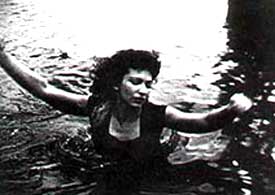 The party-goers begin encountering one another in an odd pattern of greeting, parting, greeting, parting, like an expressionistic square dance, becoming increasingly artificial, barely connecting. The party-goers begin encountering one another in an odd pattern of greeting, parting, greeting, parting, like an expressionistic square dance, becoming increasingly artificial, barely connecting.
Unexpectedly they are outdoors in the daylight, the three women dancing together like the Graces. Our younger heroine rushes across a lawn, is caught in an erotic dance part tango, part balletic leaping. The dancers' bodies are contrasted against classical statuary.
The middle doppelganger (Maya) appears in the young woman's stead, & she sees the still older doppelganger (Anais) dancing with the young hot stud. The youngest of the three walks away through a garden, & comes to a statue which is the young man she had been dancing with.
She flees in terror as the statue comes to life & pursues her by leaps & bounds. She continues running as in a nighmare, almost caught, escaping into the sea. But turns she is the youngest & she is the middle doppelganger, & finally she is sinking into the ocean depths, never to arise.
copyright © by Paghat the Ratgirl
|
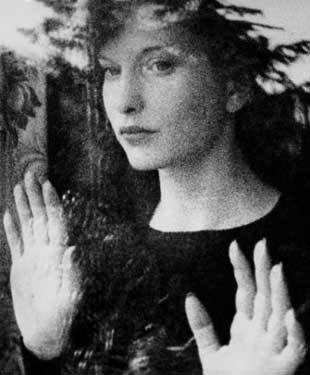
 While working as personal secretary to dance choreographer Katherine Dunham, Deren went with the Dunham Dance Company to Hollywood & there met cameraman Alexander "Sasha" Hamid nee Hackenschmied. He would become her second husband, moving with her to Greenwich Village. Throughout this period she pal'd around with Andre Breton, Marcel Duchamp, John Cage, Ana‘s Nin & suchlike.
While working as personal secretary to dance choreographer Katherine Dunham, Deren went with the Dunham Dance Company to Hollywood & there met cameraman Alexander "Sasha" Hamid nee Hackenschmied. He would become her second husband, moving with her to Greenwich Village. Throughout this period she pal'd around with Andre Breton, Marcel Duchamp, John Cage, Ana‘s Nin & suchlike.

 He leads her to a log cabin, but she can barely keep up, & he closes the door before she arrives; it's a moment that most clearly identifies this as a film about loss & abandonment. She crawls under the cabin & up into a large modern home, obviously not the cabin, with furniture covered in sheets.
He leads her to a log cabin, but she can barely keep up, & he closes the door before she arrives; it's a moment that most clearly identifies this as a film about loss & abandonment. She crawls under the cabin & up into a large modern home, obviously not the cabin, with furniture covered in sheets.
 The party-goers begin encountering one another in an odd pattern of greeting, parting, greeting, parting, like an expressionistic square dance, becoming increasingly artificial, barely connecting.
The party-goers begin encountering one another in an odd pattern of greeting, parting, greeting, parting, like an expressionistic square dance, becoming increasingly artificial, barely connecting.